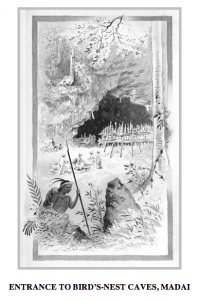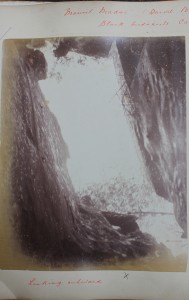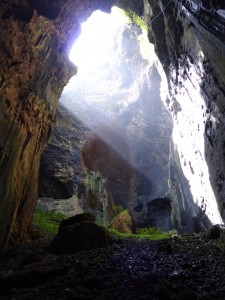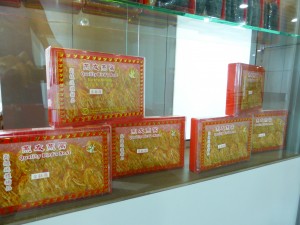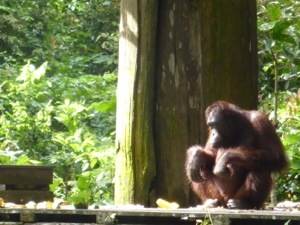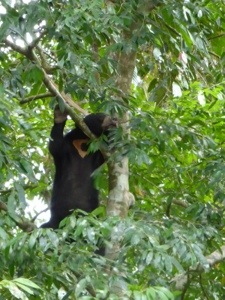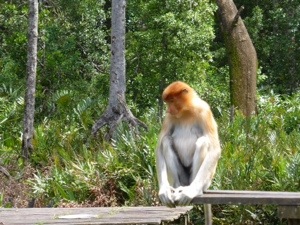The Great Barrier Reef is arguably THE destination in Australia. Learning to dive at the beginning of the year, this was firmly on my list of places to visit. I had my concerns though, The Great Barrier Reef is under threat, at risk from many directions: climate change, mining, tourism. It may not be all it’s cracked up to be, the parts visited from Cairns by mass tourist vessels, the enormous industry around it with fixed pontoons out at sea and 300 passenger catamarans shuttling back and forth fill me with sadness and fear about the impact that this is having on the very thing it is celebrating. I wonder how long this is sustainable (although it probably has more to fear from the mining industry at the moment, as it dumps waste out at sea). My hope is, however, that it is such a vast entity that at least these pontoons keep tourists in roughly the same place.
In Borneo, just after leaving Indonesia, I went diving, making sure I could still do it, and without my instructor. All went well, despite poor visibility. I saw a turtle for the first time, and a lobster. After a wobble in my confidence around New South Wales I booked a dive while sailing in the Whitsundays (not the best outfit to go with but I did see a reef shark for the first time), I haven’t looked back. Stuck in Townsville and uncertain if I would make it to Cairns, I booked another dive – officially on the Great Barrier Reef here – and it was (as they say) pristine. There was no plastic, no nappies, just sea life. It was a couple of hours off the coast and felt wonderfully remote, a bit of a secret spot. The corals were beautiful. I did, however, learn to dive in Bali. I fear this has, to some extent, ruined me, I cannot be as awe inspired by these wonders, my standards are high, but this was beautiful. A mixed blessing, I finally got to leave Townsville, but on the day I could have dived at the ship wreck Yongala, renowned to be a pretty special place. Arriving at Cairns Easter weekend, with just three days before my flight back to Brisbane, my only option was to book a trip on one of the enormous catamarans out to a pontoon. The weather was ropey, so to be on a small boat may not have been a good idea, as it was the boat I was on was carnage, almost everyone was seasick. The dive briefing was a thorough and professional affair, it turned out there were just three of us diving, this was some relief, at least once under the water it was peaceful. Despite all the commotion on the surface, there remains a good deal of life under the water, a particularly friendly Maori Wrasse, several feet across, greeted me and, ignoring the structural supports, the reef was being looked after and in what seemed like pretty good condition, Tour operators are also required to fulfil various ‘environmental’ checks and demands. The highlight was the turtle, having passed us by several times during the day, just before ascending back to the surface it started having its lunch. We were able to ‘sit’ and watch for some time as it ate algae from the coral, just the three of us within a few feet of each other. It felt a very special thing to be able to do.
One of other great things you can do in Cairns is to go to the Reef Teach talk and adopt your very own marine biologist. From the tiny things to the giants of the sea, it gives a great over view. The extent of the reef is incredible, one of the wonders of the world you can see from space and filled with such variety of living things. One of the parting words for this talk is also about sharks, and it is something that has preoccupied me during my time here, following the Western Australia shark culling programme.

My first go with a Go-Pro…this is where the white tipped reef shark was a split second before (admittedly the visibility wasn’t brilliant)
‘Jaws’ has a lot to answer for, it certainly holds a good deal of responsibility for my own fear of the open water. But with more information and understanding fear is reduced. What is alarming is that much of Australia (and the rest of the world) seems to be acting on the basis of these fears, killing sharks in enormous numbers (that and shark fin soup, which is tasteless admit it China, where sharks fins are cut off and the creature is left to drown). The majority are of no risk to people. When my dive guide at the Whitsundays made the sign for ‘shark’ I have to admit several things ran through my mind, but seeing it was breathtaking. The white tipped reef shark, just a few feet long and with no interest in us, was sleeping on the sea bed. As we approached it swam off, and as it did there was something incredibly tangible about its history and time that it has been here (more than 450 million years). Something so elegant and graceful and a feeling of another time and another world.
I can’t say I’m a fan of sharks now, but I am certainly in awe. They are also at the top of the food chain out there so we need them. Unfortunately too many are being killed, some are near extinction. This is senseless. Sadly around 10 people die each year from shark attacks in the world. In response to this however, 100 million sharks are being killed every year, 100 million!. To put this in context, the most dangerous creature in the world, is the mosquito, responsible for 725,000 deaths each year. In Australia, you are more likely to be killed by a eucalyptus tree than you are a shark. With all the bravado of how dangerous Australia is, it seems to have swallowed its own story, nothing there actually wants to kill you. Cancer, diabetes and heart disease are still responsible for most deaths. Something seems to be getting lost in communication. We need the sharks. We need to be careful venturing into their habitat (as you would with lions and tigers) but killing them all is not the answer. So this is my parting plea, to raise awareness in what small way I can and to be someone who will talk and learn more about sharks. The Western Australian cull has come to an end for now, I only hope that some sense is seen and that the devastation that has been done to many endangered species can have time for repair.
For a beautifully illustrated film of the plight of sharks watch this.


